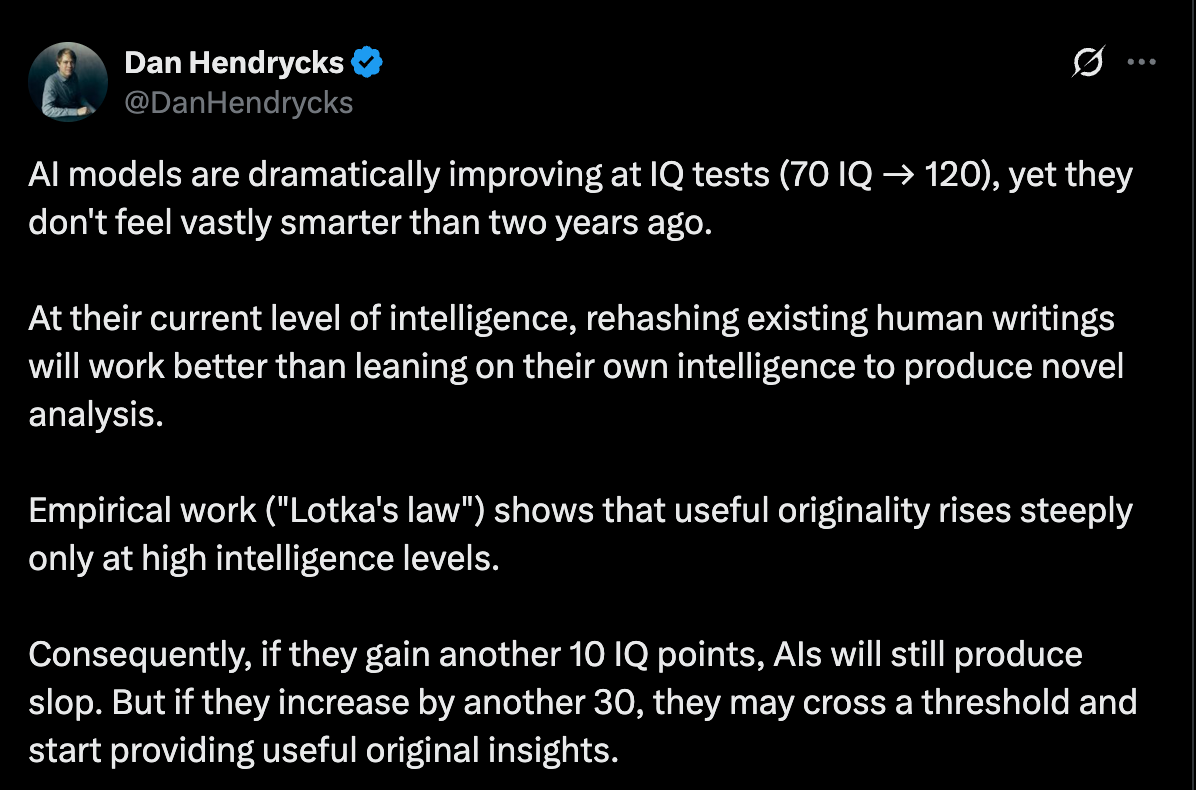From Trump to TESCREAL, Eugenics Is Everywhere
Most people think eugenics largely vanished after the Nazis' atrocities. But that's not true: eugenics is alive and well, and probably more influential today than ever. (2,200 words.)
Most people who are familiar with the word “eugenics” immediately think of the atrocities committed by the Nazis, who force sterilized some 400,000 people and killed another 300,000 as part of the euthanasia program later dubbed, in post-war trials of doctors, Aktion T4. Most also assume that the monstrosity of eugenics went into hiding after the Second World War.
But this is incorrect. First of all, as I observe in a forthcoming article for the Oxford Research Encyclopedia titled “TESCREAL,” eugenic practices date back
to the origins of the Western tradition. For example, the “Twelve Tables” of Roman law, ratified in 449 BCE, “made provisions for infanticide on the basis of deformity and weakness.” In the first century CE, the Roman philosopher Seneca wrote that
we put down mad dogs; we kill the wild, untamed ox; we use the knife on sick sheep to stop their infecting the flock; we destroy abnormal offspring at birth; children, too, if they are born weak or deformed, we drown. Yet this is not the work of anger, but of reason — to separate the sound from the worthless.
Plato and Aristotle endorsed versions of eugenics, and eugenics bubbled up throughout the Middle Ages and into the 18th-century Enlightenment, as when the “French historian and jurist Guillaume Poncet de la Grave discouraged miscegenation, arguing that ‘it exposed French blood to corruption and produced disfigured children.’”1
Eugenics in the Postwar Era
Even more striking is that
eugenics continued to be practiced after the atrocities of the Second World War came into clear view. California’s [eugenics] program,2 for instance, was not officially terminated until 1979, and some countries previously occupied by the Nazis initiated their own programs after the war concluded [such as Denmark, Finland, and Norway]. Japan enacted its Eugenic Protection Law in 1948, which resulted in roughly 25,000 people being sterilized between its enactment and abolition in 1996. There is, to paraphrase some scholars, continuity of eugenics across the 20th century.3
By the 1970s and 1980s, a “second-wave eugenics emerged as an offshoot of genetics and biotechnology.” By the early 1990s, modern transhumanism was formalized by the early Extropian movement, which borrowed the term “transhumanism” from Julian Huxley — himself an ardent eugenicist who presided over the British Eugenics Society (which still exists as the Adelphi Genetics Forum) during the postwar era, from 1959 to 1962.4
As I’ve said on many podcasts and radio interviews, transhumanism could be understood as eugenics on steroids. Whereas the 20th-century eugenicists aimed to:
perfect the human species, and
prevent the human species from evolutionarily degenerating (a huge source of anxiety in the latter 1800s and early 1900s, as exemplified by the eugenicist H. G. Wells’ novel The Time Machine) …
transhumanists want to create an entirely new species of “posthumans” to usurp humanity’s place in the universe. This is why transhumanism is eugenics “on steroids.”
A Protean Idea — Always Shifting Shapes
The point is that eugenics is an idea that just won’t die. It’s been around since the origins of the Western tradition, and it persisted through and beyond the horrific atrocities committed by the Nazis to eliminate what they called “life unworthy of life.” The reason many people don’t know that eugenics is alive and well today is that it’s also a protean phenomenon: it evolves over time, taking on novel forms, shapes, and sizes, and these new manifestations sometimes look sufficiently different from previous forms that people don’t initially recognize it as eugenic.
The TESCREAL movement, I claim (along with Dr. Timnit Gebru), is just the most recent iteration of the “eternal return of eugenics” — quoting two French scholars. In the place of forced sterilization, there’s now a push to develop advanced technologies enabling us to radically reengineer the human organism over the course of a single lifetime, or across one generation (in the case of parents genetically modifying their children). This contrasts with the 20th-century eugenicists’ proposals that involved, basically, selective breeding, which requires transgenerational timescales to operate (because “desirable” or “fit” individuals in each generation have to produce more children than “undesirable” or “unfit” people).
At the extreme, some TESCREALists argue that we should just create a new species of posthumans in the form of AGI, which can then replace us as our “worthy successors.” Given its emphasis on creating posthumanity through technology, the entire TESCREAL movement can be seen as built on a pro-extinctionist vision of the future — one in which Homo sapiens is sidelined, disempowered, marginalized, and eventually eliminated. The “worthy successor” idea is a particular variant of pro-extinctionism that might be called digital eugenics.
The World’s Most Powerful Genetic Predictor of IQ (Lol)
All of this is prefatory to a few recent examples of eugenics that I’d like to foreground. For example, I came across this tweet the other day about “CogPGT,” described as “the world’s most powerful genetic predictor of IQ.”

A press release claims that the system “is able to detect on average an 8.5 IQ point difference between just three embryos,” adding that
intelligence is a trait that many parents using IVF will wish to consider alongside a variety of health traits when prioritizing which embryo to transfer. Indeed, as we show below, intelligence is associated with a variety of life outcomes, including overall health and length of life. For this reason, while intelligence is quite different from disease traits like diabetes and breast cancer, it can also be seen as a trait that contributes to psychological and physical well-being.
This is eugenics, and as with the “scientific” eugenics movement of the 20th century, it’s based on a deeply problematic — and historically racist — notion of “intelligence” and “IQ.” Gebru and I go into some detail about the racist origins of “IQ” in our paper, at one point quoting the scholar Daphne Martschenko, who says in an article for The Conversation: “In their darkest moments, IQ tests became a powerful way to exclude and control marginalised communities using empirical and scientific language.”
Such tests were, indeed, created by white men who often held overtly racist views, and they were designed to produce the results that those men wanted — that is, to confirm their prior beliefs that the “white race” is intellectually superior.
In fact, a Black scholar named Dr. Robert Williams (also coiner of the word “ebonics”) developed an intelligence test in 1972 called the “Black Intelligence Test of Cultural Homogeneity,” which focused on cultural and linguistic knowledge common within Black communities. And surprise, “the results of the test showed that the black group performed much better than the white group.” In other words, according to this alternative “intelligence” test, Black people were on average more “intelligent” than whites.
In this interview, Dr. Williams says he scored an 82 (!!) on traditional IQ tests, and was motivated to develop his alternative because of biases embedded in those traditional tests.Brief Tangent on “Intelligence”
IQ testing is also problematic because it assumes that “general intelligence” can be accurately measured on a single, linear, one-dimensional numerical scale. All humans can thus be neatly ranked on the resulting hierarchy of intellectual ability.
This strikes me as an outrageously impoverished way of thinking about “intelligence,” as there are a million different ways to be “intelligent” — just as there are a million different ways to be “skilled.” (I like this analogy between intelligence and skilledness.) If someone were to say, “Hey, you really ought to meet my friend John — he’s incredibly skilled,” you would of course reply: “Like, in what way is he skilled?” That’s the way I respond when someone tells me that I ought to meet so-and-so because they’re “incredibly intelligent.” Consider the following examples, which I’ll probably elaborate on in a subsequent article:
Trevor Rainbolt (his actual surname) is a world-class GeoGuessr. The guy is truly phenomenal. He’s memorized half of the world’s roads, and even many indoor spaces (at zoos, schools, etc.) on Google Maps — see for yourself below. I am blown away by his genius.
But is he more “intelligent” than, say, Judith Butler? If you’re an IQ realist who thinks that IQ tests measure some real property of individuals, there should be a clear cut answer to this question! Butler has an exquisitely sharp analytical mind, and their scholarship is amazingly original and full of insight. Butler’s books and articles have forced many people, including myself, to see phenomena like gender in a completely novel way.
Now compare Butler to the author and activist Naomi Klein. To my knowledge, Klein hasn’t made any significant academic contributions to fields like philosophy or climate science (the latter of which she writes about). I don’t think she’s published many (or any?) peer-reviewed articles. Yet she’s a brilliant thinker and writer. For a chuckle: when someone asked me a few years ago what I thought of her extraordinary book Doppelganger, I said that “I found the book to be an incredibly frustrating read.” Taken aback by this response, they asked me to clarify, which I did as follows: “Every page of her booked reminded me of how mediocre a writer I am in comparison to her!” LOL!!
Now compare Klein to my favorite ice hockey player, Connor McDavid. McDavid is also a genius, but of a rather different sort. His cognitive ability to see the ice in ways that no one else can, to process complex realtime information about physics and high-level hockey strategy in a moment, etc. is absolutely mind-boggling. McDavid is a kinesthetic genius, though there’s also a ton of high-level strategy that playing at his level requires (I know because I tried out for and made a AAA hockey team when I was a teenager: the Little Capitals.)
The point is that there’s simply no plausible way to rank such people on a single, linear scale of “intelligence.” The absurdity of this situation becomes even more acute when one considers the likes of Freddie Mercury, Curt Cobain, Picasso, Marie Curie, John von Neumann, Vincent van Gogh, Mary Anning, Claude Debussy, Kim Peek, etc. How the heck can such people be unambiguously ranked according to their “intelligence,” given that their intellectual talents are so different?
It’s like asking someone to rank a list of 100 different plumbers, carpenters, cooks, and potters on a single, linear scale of “skill.” Or asking someone to rank da Vinci’s “Mona Lisa,” van Gogh’s “Starry Night,” Michelangelo’s “David,” the Eiffel Tower, and a gorgeous sunset on a scale of “beauty.” You can’t coherently do this because it can’t be done. So, “intelligence” is not a single, easily measurable phenomenon — it’s a constellation of incommensurable and extremely hard-to-quantify capacities, which is why talk of “intelligence” within the tradition of “IQ” is, to me, utterly meaningless.
IQ Realists: “A Scary Bunch”
Worse, as the otherwise abhorrent Bryan Caplan writes, people who believe that IQ is a meaningful measure of “intelligence” (IQ realists) are oftentimes a quite “scary bunch.” He elaborates:
People who vocally defend the power of IQ are vastly more likely than normal people to advocate extreme human rights violations. I’ve heard IQ realists advocate a One-Child Policy for people with low IQs. I’ve heard IQ realists advocate a No-Child Policy for people with low IQs. I’ve heard IQ realists advocate forced sterilization for people with low IQs. I’ve heard IQ realists advocate forcible exile of people with low IQs – fellow citizens, not just immigrants. I’ve heard IQ realists advocate murdering people with low IQs.
When I say, “I’ve heard…” I’m not just talking about stuff I’ve read on the Internet. I’m talking about what IQ realists have told me to my face. In my experience, if a stranger brings up low IQ in Africa, there’s about a 50/50 chance he casually transitions to forced sterilization or mass murder of hundreds of millions of human beings as an intriguing response. You can protest that they’re just trolling, but these folks seemed frighteningly sincere to me.
The Ubiquity of Eugenics
This brings us back to the contemporary eugenics movement. When I was looking through my Twitter/X bookmarks for the “CogPGT” post, I found a dishearteningly large treasure trove of similar examples that I’d saved for future reference. For example, someone named Jeremy Kauffman, who has nearly a quarter-million followers on X, posted this last year:

Liron Shapira, a noted TESCREALists within the AI doomer/safety camp, writes:

Another AI safety figure named Dan Hendrycks — founder of the Center for AI Safety and an advisor at xAI — posted this image:

Above the image were these claims:

Someone else in the TESCREAL community, Nathan Young, noted last year that “a friend sent me this from a dating app they signed up to.” The app includes a request for one’s IQ:

Whether or not Young signed up, it’s no secret that TESCREALists are obsessed with IQ. I was told — but have not independently verified — that at some Rationalist meetings in the Bay Area, people introduce themselves by stating their name followed by a number. That number? One’s IQ. (See this article of mine for a detailed look at TESCREALism, eugenics, and IQ.)
As Gebru and I wrote, quoting a Vox article by Carla Cremer:
Carla Cremer, a former EA, reports that the Centre for Effective Altruism tested “a new measure of value to apply to people: a metric called PELTIV, which stood for ‘Potential Expected Long-Term Instrumental Value.’” The aim was to identify members of the community “who were likely to develop high ‘dedication’ to EA,” and the score was based in part on members’ IQs. She wrote:
A candidate with a normal IQ of 100 would be subtracted PELTIV points, because points could only be earned above an IQ of 120. Low PELTIV value was assigned to applicants who worked to reduce global poverty or mitigate climate change, while the highest value was assigned to those who directly worked for EA organizations or on artificial intelligence.
Eugenics and MAGA
And, of course, there are far-right figures like “End Wokeness” that have taken up and promoted the eugenic notion that IQ is a meaningful measure of “intelligence” and that we should be concerned about people from “low-IQ” countries immigrating to the US:

Finally, here’s Darren Beattie, the current Senior Bureau Official in Public Diplomacy in Trump’s State Department, saying that “when a population gets feral, a little snip snip keeps things in control,” to which he adds that you could incentivize Black people to get vasectomies by offering them “Air Jordans.” F*cking hell:

Conclusion
Eugenics never went away. It’s as influential as it’s ever been, echoed in proclamations from Trump that immigrants are “poisoning the blood of our country” and the new pronatalist movement led by people like Malcolm and Simone Collins. It’s also at the very heart of the TESCREAL movement, which is what launched the current race to build “basically a digital god,” in Musk’s words, that could replace humanity. Once you realize that eugenics is still dancing, you’ll notice it everywhere. In many ways, the current zeitgeist is imbued by eugenics ideologies, much of it fueled by racist, sexist, classist, and even anti-human attitudes. Yikes.
Thanks so much for reading and I’ll see you on the other side!
Also from my forthcoming article.
Which explicitly inspired the Nazis’ eugenics program, as it happens.
Same as footnote 1.
To be clear, Huxley didn’t coin the term “transhumanism,” but he did popularize it in his 1957 book New Bottles for New Wine.



Many women in ICE detention are reporting forced sterilization by unqualified personnel
https://www.cbsnews.com/news/women-detained-ice-unnecessary-gynecological-procedures-georgia-facility-investigation/
Yes. And it gets more brazen by the day. Hayek's bastards must be stopped.